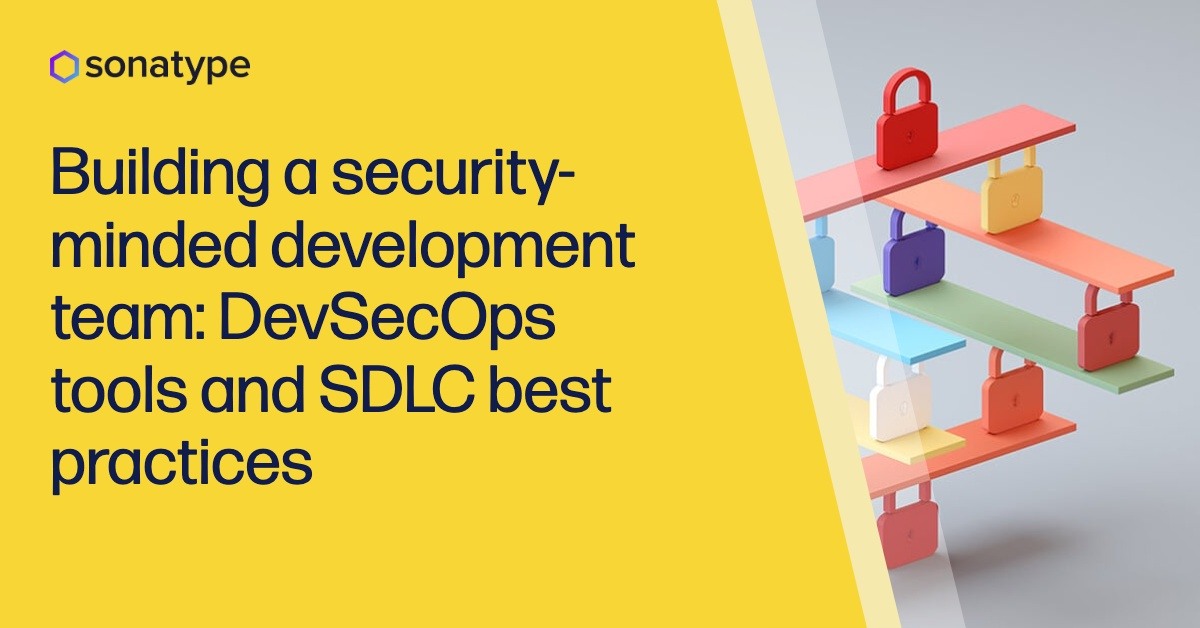Building a Security-Minded Development Team: DevSecOps Tools and SDLC Best Practices
7 minute read time

In an increasingly adversarial threat landscape, software security can't be just one more checkpoint on the road to your next release. It should be integral to how every member of your development team works, from developers and DevOps professionals to quality assurance testers and project managers. As your organization faces increasingly sophisticated threats, a security-minded development team has evolved from a "nice-to-have" into a business imperative.
Unfortunately, many development teams struggle to integrate security practices into their workflows. The challenge isn't just implementing the right tools or following a security checklist. It's also fostering a shift left culture where security becomes second nature to every team member.
Let's explore how your organization can build and nurture security-minded development teams through strategic leadership, practical tools, and proven best practices. We'll look at how you can establish security objectives that align with business goals, leverage timely vulnerability and malware intelligence, and use automation to protect against critical threats like software supply chain attacks and open source malware.
Software Security Starts at the Top
A security-minded development team requires strong leadership support. When executives demonstrate that security is a core organizational value, not just an IT concern, it can fundamentally shift how teams approach their daily work.
Consider the ways your organization's leadership might model and motivate secure behavior. Examples include actively participating in security training and regular organizational discussions.
Many successful organizations establish dedicated communication channels where leadership and teams can:
-
share security priorities,
-
discuss incident learnings, and
-
stay current on policy updates.
Organizations that excel at application security typically allocate dedicated resources for modern security tools, including repository management systems, software composition analysis (SCA) tools, and automated policy enforcement capabilities. A proactive, executive-sponsored approach to security tooling helps position security as an essential business function, rather than a cost center.
Shift-Left Security: Introduce Security Early in the SDLC
Shifting security left means integrating security tools and practices into the earliest stages of development. A proactive approach helps teams identify and address potential security risks early in the software development life cycle (SDLC), when changes are least disruptive and most cost-effective.
The business case for early security integration is compelling. According to NIST research, fixing vulnerabilities during the design and coding phases costs up to 30 times less than post-deployment remediation.
Effective shift-left security strategies integrate security intelligence with prioritized alerts directly into developers' existing workflows, from version control to CI/CD pipelines. When meaningful and actionable insights are available in the tools developers use every day, software security becomes a routine aspect of the development process. Developers take ownership of secure coding practices, rather than view security as the exclusive concern of security and IT professionals.
5 Steps to Building a Software Security Culture
Define Clear Software Security Objectives
Effective security programs start with clearly defined objectives that align with your organization's priorities and risk tolerance. Rather than setting vague goals like "improve security," successful teams establish specific, measurable targets that resonate across different roles and responsibilities.
Consider developing role-specific security playbooks that translate high-level objectives into concrete daily practices. For developers, that could include clear guidelines for evaluating open source dependencies and responding to alerts about software supply chain risks. For DevOps teams, guidelines might focus on maintaining secure repositories and implementing automated security gates.
Make security objectives visible by integrating metrics into project dashboards and sprint reviews. Track remediated vulnerabilities and policy compliance. Be sure to celebrate individuals and teams that consistently meet software security standards. It will help cement security as a rewarding part of their daily workflows.
Increase Education About Open Source Malware and Risks
It's important to understand that not all open source security risks are the same. While vulnerabilities in legitimate open source components can create security gaps, malicious open source packages represent a different and often more urgent threat. Think of open source vulnerabilities as unintentional flaws that could be exploited, while open source malware is code deliberately designed to cause harm.
This distinction matters for prioritization. While teams often plan vulnerability remediation thoughtfully during sprint cycles, deliberately malicious code requires immediate action to prevent active harm. A vulnerability in a logging library might need fixing in the next release cycle, but discovering malware in your dependency tree demands immediate quarantine and removal.
Ensuring your team understands these differences helps them make better decisions about risk prioritization and response times, ultimately leading to more effective security practices.
Foster Cross-Functional Collaboration
Effective software security requires breaking down traditional silos between development, security, and operations teams — hence the term DevSecOps. When security teams participate in early planning stages, they can help identify potential risks before code is written. Similarly, when developers understand security requirements from the start, they can make better decisions about software architectures and dependencies.
Consider establishing regular touchpoints between teams, such as security representatives joining planning sessions and architecture reviews. Product owners should include security requirements in user stories, making them integral to feature development as functionality requirements.
A collaborative approach helps teams identify security considerations early, when they're easiest to address, while ensuring security measures align with business objectives and user needs.
Integrate Security Tools and Insights to Keep Your SDLC Secure
Security tools are most effective when they seamlessly integrate into developers' existing workflows, rather than requiring context switches or extra steps. The key is to provide security insights where and when developers need them — directly in their IDEs and build pipelines.
For example:
-
DevSecOps tools like Sonatype Lifecycle, a dependency management and software composition analysis tool, embed continuous monitoring and detailed component intelligence throughout the development process.
-
Repository management tools like Sonatype Nexus Repository help teams maintain a single source of truth for verified, secure components.
-
Sonatype Repository Firewall identifies and intercepts open source malware, helping developers prevent malicious components from entering their supply chain.
This automated, real-time approach to security creates a natural feedback loop that strengthens security culture. When developers receive immediate insights about security issues, along with clear guidance for resolving them, security becomes an organic part of the development process.
Maintain Transparency and Accountability
A security-minded development culture is built on open communication about security incidents and clear ownership of security practices. When teams share their experiences with vulnerabilities and malware, they create valuable learning opportunities for the entire organization.
Consider implementing blameless security retrospectives, where teams can openly discuss security incidents and near-misses. Focus on systemic improvements, rather than individual mistakes. For example, if a vulnerable dependency entered production, examine the process and security software gaps that allowed it, rather than who approved the component.
Automated security dashboards can help maintain accountability while fostering collective ownership. Track key metrics, such as mean time to remediation and policy violation rates. Making these metrics visible to everyone, from developers to executives, helps create a sense of shared responsibility for security outcomes.
The Critical Role of Open Source Software Governance
Building a security-minded development team requires giving developers the right tools and knowledge to make informed decisions about open source usage. When teams understand both the benefits and risks of open source components, they're better equipped to make security-conscious choices throughout the development life cycle.
Sonatype provides an integrated toolset to support security-minded development:
-
Sonatype Nexus Repository gives developers a trusted source for secure components.
-
Sonatype Repository Firewall helps developers avoid malicious packages automatically.
-
Sonatype Lifecycle provides actionable security intelligence.
-
Sonatype SBOM Manager enables developers to track and manage component usage effectively.
When developers have the right tools and information, secure development becomes a natural part of their workflow, rather than an extra burden. To learn more, talk to a software security expert today.

Aaron is a technical writer on Sonatype's Marketing team. He works at a crossroads of technical writing, developer advocacy, software development, and open source. He aims to get developers and non-technical collaborators to work well together via experimentation, feedback, and iteration so they ...
Explore All Posts by Aaron LinskensTags

Code 3x Faster with Less False Positives
Build, test, and launch secure applications without rework. Explore how the Sonatype platform can enhance productivity and security.